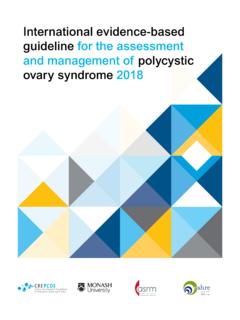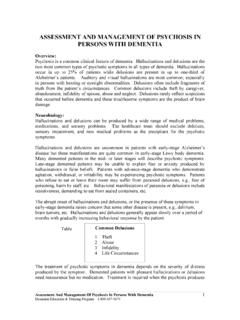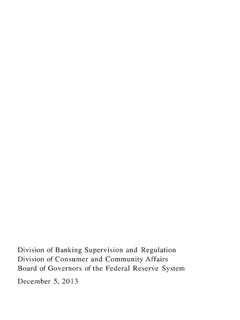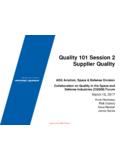Transcription of Assessment, investigations & management (PCOS)
1 polycystic ovary Health professional tool syndrome assessment , investigations & management (PCOS). PCOS assessment Clinical presentation Prevalence most common endocrine disorder in women of reproductive age (8-13%). Consider PCOS if female presents with: menstrual irregularity, overweight, hirsutism, acne, fertility issues, prediabetes, gestational diabetes or early onset type 2 diabetes Note high-risk ethnic groups (Asian, Indigenous, Nth African). Diagnosis: according to Rotterdam diagnostic criteria Step 1: Irregular Irregular cycles Clinical hyperandrogenism cycles + clinical In women >3 years post menarche to In adolescents: hirsutism (severe in adolescents). hyperandrogenism perimenopause: no period by age 15 acne (severe in adolescents). (exclude other causes)*. <21 or >35 day cycles indicating >1 year post menarche alopecia (androgenic). = diagnosis anovulation cycles >90 days >1 to <3 years post menarche cycles <21 or >45 days Step 2: If no clinical Biochemical androgens: *Refer to endocrinologist for exclusion of other hyperandrogenism measure after 3-month cessation of COCP causes if: Test for biochemical (ensure alternate contraception) clinically significant hyperandrogenism or hyperandrogenism measure sex hormone-binding globulin (SHBG) in rapid onset or severe hyperandrogenism / virilisation addition to total testosterone, to obtain free androgen testosterone levels >20% above normal limit (exclude other causes)*.
2 Index or calculated free testosterone = diagnosis Step 3: If ONLY Adolescents Adults irregular cycles OR Ultrasound should not be used for the diagnosis of In patients with irregular menstrual cycles and hyperandrogenism- PCOS in those <8 years after menarche, due to the high hyperandrogenism, an ovarian ultrasound is not ultrasound incidence of multi-follicular ovaries in this life stage necessary for PCOS diagnosis Should be considered at risk of PCOS and receive Ultrasound (for PCOM) will identify the complete follow-up assessment PCOS phenotype * investigations /exclusion of other causes TSH, Prolactin levels, FSH and if clinical status indicates other causes need to be excluded (eg CAH, Cushing's, adrenal tumours etc). Hypogonadotrophic hypogonadism (generally due to low body fat or intensive exercise) should also be excluded clinically and with LH and FSH levels. PCOS management PCOS management should be Referral guidance Lifestyle In those with more complex PCOS or considered across the lifespan with challenges in differential diagnosis, Healthy lifestyle behaviours encompassing and individualised, making healthy eating and regular physical activity consider referral to an endocrinologist or should be recommended in all those with sure that patient priorities are multidisciplinary service PCOS to: identified.
3 Consider early referral to fertility specialist achieve and/or maintain healthy particularly if age >/= to 35 years. In younger weight Consider the benefit of a GP women consider up to 12 months of intensive optimise hormonal outcomes, general management Plan and Team lifestyle intervention such as weight loss, health, and quality of life across the Care Arrangement. where appropriate, before referral. life course. Realistic weight loss goals vital (5-10%. A team/multidisciplinary PCOS management areas include: body weight). approach with GP coordination lifestyle No specific diet, focus on: should be considered, where clinical hyperandrogenism (eg hirsutism) reducing overall caloric intake appropriate and available. menstrual cycle regulation sustainable behavioural change fertility regular GP and self-weighing/. monitoring weight management 30 minutes of moderate to vigorous cardiometabolic health exercise daily for health goals won't sleep apnoea reduce weight alone, need diet.
4 Increase mental and emotional health. opportunistic movement, consider referral to exercise physiologist Note: this is a heterogeneous chronic condition and there is a need to engage each woman in prioritising her own management issues. Clinical hyperandrogenism Cyproterone containing COCPs should Fertility (hirsutism/acne/alopecia) be considered second-line due to BMI >25 weight loss first-line Cosmetic options: laser hair removal, increased VTE risk 5-10% weight loss may assist in cycle depilatory creams, threading, plucking, Progestogens alone may be used control and fertility waxing and electrolysis cyclically or as an IUD where COCP is contraindicated or not preferred (eg Pharmacological therapies for infertility Pharmacological therapy options (6-12 Medroxyprogesterone acetate (MPA) include letrozole or clomiphene, but months to see benefit): 10mg days 1-10 in January, April, July, in primary care, metformin can be COCP (all will assist) aim for lowest September) started before fertility specialist referral effective dose informing women that it is not as Metformin improves ovulation, Combination therapy if 6 months of effective re-establishes cycles, reduces insulin COCP is ineffective, consider adding resistance, reduces progression to Referral to fertility specialist if unable to anti-androgen to COCP diabetes, may prevent weight gain, conceive at Anti-androgen (eg spironolactone, but does not cause weight loss 12 months if <35 years usual dose 100mg-200mg daily) 6 months if >35 years Minimise side effects with starting dose Contraception is vital to prevent 1 x 500mg daily, increase by 500mg pregnancy while on anti-androgens per fortnight up to 1500mg-2000mg Key messages.
5 Average dose PCOS may limit fertility, but can be Alcohol excess should be avoided treated Menstrual cycle regulation on metformin Women with PCOS have similar family Lifestyle efforts can improve cycle sizes overall, but often need some regularity Key messages: assistance Combined oral contraceptive pill (COCP) Women with PCOS have increased risk Fertility for all women decreases in early All COCP pills increase SHBG thereby of endometrial cancer with prolonged 30s and significantly after 35 years reducing free androgens; provide amenorrhoea; aim for >4 periods/ year Advise early family initiation (<35 years). contraception, endometrial protection unless on COCP. where practicable and cycle regulation (monitor glucose If cycles <4 per year progestogen tolerance in those at risk of diabetes as Being overweight, obese or underweight (eg, MPA) to induce a withdrawal bleed may increase insulin resistance) can affect fertility if patient does not want to commence No COCP has been shown to be COCP Prevent weight gain and aim for weight better than another loss if needed Weight management medical and/or surgical weight loss Mental & emotional health Monitor weight regularly, important for: treatments In women with PCOS there is a high prevalence of moderate to severe targeting prevention of weight gain in all (if a healthy weight or overweight) Key message: anxiety and depressive symptoms achieving at least 5-10% weight loss if 5-10% weight loss will greatly assist in Screen for anxiety and depressive overweight symptom control symptoms at diagnosis Note.
6 Education alone and setting Eating disorders, negative body image, unachievable goals are generally Cardiometabolic health low self-esteem and psychosexual unsuccessful dysfunction should also be considered Screen for cardiovascular risk factors: Encourage simple behaviour change smoking advise cessation If screening is positive, assess risk factors prioritisation of healthy lifestyle, family and symptoms using an appropriate support, lifestyle and exercise planning, BP: check annually assessment tool (GAD7 or PHQ). setting of small achievable goals Lipid profile at baseline if BMI >25, then according to overall CVD risk: check every If treatment is required, consider a Mental Calorie deficit of 500-750 cal daily 2-4 years Health Treatment Plan (MHTP), ongoing required for weight loss (ie 1200-1500 cal support and/or referral to a mental health daily intake), with no one diet preferred Diabetes: professional 3-5 fold increased risk and earlier onset 250 min moderate exercise/week or of gestational, prediabetes and diabetes 150 min vigorous exercise/week required Key message: in PCOS; these also occur in lean and in Assess mental and emotional health for: for weight loss young PCOS women Consider referral via team care depression and/or anxiety Screen with OGTT, fasting glucose arrangement if appropriate: body image or HbA1c.
7 If high risk use OGTT (eg, dietitian (tailored dietary advice, history of GDM, IFG, IGT, family history eating disorders and disordered eating education, behavioural change support) of diabetes, hypertension or high-risk psychosexual dysfunction exercise physiologist (exercise ethnicity). motivation, education). Every 1-3 years (annually if IFG/IGT). psychologist (motivational interviewing, Sleep apnoea behaviour management techniques, Key message: Monitor clinically for sleep apnoea emotional health and motivation). Increased cardiovascular risk factors and (strongly associated with excess weight). group support (diet and exercise program) prevalence of GDM, IGT and type 2 The Berlin tool can be useful for diabetes in PCOS screening Additional information Health practitioner tools and resources management -of- polycystic -ovary-syndrome- pcos-2019. To order copies: Mental and emotional wellbeing Use assessment tools such as: Patient Health Questionnaire (PHQ).
8 Education and Generalised Anxiety Disorder Scale (GAD7). Knowledge Exchange Jean Hailes for Women's Health PO Box 33314, Domain LPO. Clinical hyperandrogenism Melbourne VIC 3004. Hirsutism Phone: 1800 JEAN HAILES (532 642). Use standardised visual scale eg Email: Modified Ferriman Gallwey score (mFG). Alopecia Clinics Ludwig visual score Jean Hailes Medical Centre for Women 173 Carinish Road Patient resources Clayton VIC 3168. Jean Hailes at Epworth Freemasons 412 Victoria Parade East Melbourne VIC 3002. This resource is informed by the International Phone: 03 9562 7555. evidence-based guideline for the assessment and management of polycystic ovary syndrome'. (Monash University 2018). Jean Hailes for Women's Health gratefully acknowledges the support of the Australian Government. Jean Hailes for Women's Health 2012 Updated October 2018.









